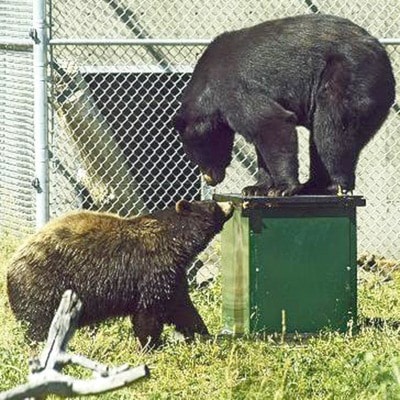By Cavelle Layes
Kamloops This Week
The specially designed garbage can could bare the bears— even after an day of pushing, pawing, clawing and gnawing.
The B.C. Wildlife Park tested the container on Tuesday, July 23 in the presence of media, business representatives and a few curious spectators — all to see if the bears could be kept out.
The bins, created by Ontario company TyeDee Bin, had undergone two successful unofficial testings before the Tuesday event — including one involving 800-pound polar bears.
While he would not say the bins were completely bear-proof, Gary Jonsson, the company’s sales and distribution manager, said he trusted his product enough to climb inside himself.
“Bears are amazing creatures,” he said. “You never know what they are going to do.”
The park’s animal-care staff explained they had spent the previous few days cutting back on the bears’ diets enough to ensure they would be hungry but not enough to cause them stress.
Earlier on Tuesday morning, park staff inspected the bins to ensure there were no sharp edges or other variables that could harm the three black bears.
The bin was bolted to a concrete slab and filled with breakfast.
Park staff explained the food inside the bin was their normal meal and what might be found inside garbage cans.
However, as incentive, the bears were given more of their favourite items, including grapes and peanut butter.
Peanut butter was also spread over the parts of the bin viewed as vulnerable.
Once released, Hamilton, the park’s 300-pound male, along with Numees and Tuk, the 200-pound females, did their best to get to their meals.
Tera Guider with the park’s animal care department said the testing is not cruel or harmful to the animals.
She explained that, because they are already in captivity, staff isn’t worried about the bears becoming accustomed to eating out of bins — and the activity of trying to open them is stimulating.
“It mimics actions they would be doing out in the wild,” she said, because bears normally turn logs and rocks trying to see what’s inside or underneath.
The bears could be seen licking and chewing, pushing and bumping and, at some points, climbing on the bin in an attempt to get to the food.
The park has already received two other requests for this kind of product testing since it is the only location in Canada certified to do this.
However, as the program is just beginning, park staff are unsure if it will happen this year.
Park general manager Glenn Grant said the test a week ago Tuesday was a success.
He said reports it will generate extra revenue for the park are wrong, however; the program generates enough to just cover its costs.
The real benefit is the contribution to conservation, Grant said, and reducing the bear-human conflict potential.
Guider said plans are to repeat the tests but they need to allow for a gap so that the bears don’t get bored with the challenge of trying to break into the bins.
“If we do it too often they might lose interest and that will impact the results,” Guider said.
“Who knows? They might be great and be able to do it after just a couple weeks’ rest.”
Staff must also keep in mind the animals’ habits, she said, noting it would be silly to book a testing when the bears are preparing to hibernate and are not active.
Guider explained staff will continue to closely watch the bears and, if they stop enjoying the tests, will consider ending the program.
